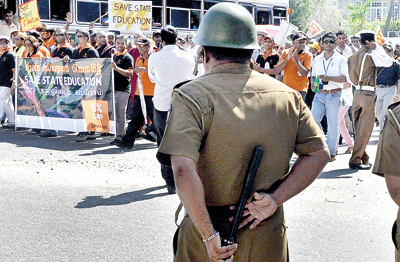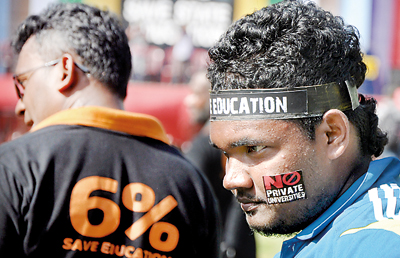The FUTA Protest
September 29, 2012, 6:36 pm , SUNDAY ISLANDFUTA put up a good show on Friday, as well it might, given the support it drew from disparate opposition forces hoping that the long-drawn struggle of university academics would be the incubus of regime change. Many motorists and other commuters in the city cursed the disruption and the traffic jams caused as a result of the several processions converging on Colombo from different directions. The police unsuccessfully sought a court order to ban a procession in the interest of preventing the inevitable chaos but most people, even those worst affected, were glad that the right to protest was upheld. Given that the police never invoke judicial intervention when incumbent regimes have their various carnivals to the detriment of the general population, it was refreshing that opponents of the government were granted the opportunity of having their say.
Most people do not believe that the demand that six percent of national GDP be spent on education is FUTA’s primary objective. That demand was cannily attached to the salary increase the academics are pushing for themselves to ensure wider support for their cause. They’ve certainly won a level of public support they might not have anticipated given the pathetic state of so-called free education in the country today. Higher Education Minister S.B. Dissanayake claims that the total education spend is a much higher proportion of GDP than commonly believed. He is right if expenditure by non-State actors including various private participants like international schools, the various organizations offering higher education in a multiplicity of disciplines, what is drawn into the monolithic private tuition industry and daham pasalas, Sunday schools and Madrasas are all taken to account. The ``pearl of great price’’ that Dr. C.W.W. Kannangara bequeathed this nation is now old hat. Education is anything but free with many parents, particularly those aspiring to send their children to university, having to cough out rupees they can ill afford to pay for their children to go from this tuition class to that. Even a few of those university dons, striking for higher salaries, are part of that industry with some reportedly earning very big bucks from their `private practice.’
It is not only education that is no longer free in this country which once prided itself on a well-funded free education system from primary schools right through university. We once boasted the highest level of literacy in the region but today many rural schools are being closed and admission to the better equipped and funded schools has become a racket about which the less said the better. The once vaunted free health care is today anything but free with patients in government hospitals being compelled to obtain drugs, tests etc. from outside. We allowed our English language skills to be severely eroded; well-run State assisted denominational schools providing a useful service were undermined. It is clear that the FUTA struggle has resonated in the public mind the way it has largely on account of the progressive deterioration of welfare services, particularly education and health, in recent years. It is true that we are not a resource rich country and some economists believe that we have paid a heavy price in the lack of development by adopting unaffordable welfare expenditure. These are all matters that are debatable but it is inescapable that what is offered to the people today, especially in the spheres of health and education, is but a shadow of what was previously available; and the increase in population by no means tell the whole story.
Although the war ended three years ago, we continue to incur huge defence expenditures ostensibly for security reasons. While infrastructure must undoubtedly be developed for economic advancement, there are questions on whether mega projects like the Hambantota port and the international airport at Mattala will yield the anticipated returns. The money poured into Mihinair is a scandal and there are strong doubts on whether the airline will ever earn its keep. The people are not blind to the money the political establishment spends on itself with a jumbo cabinet of over a 100 ministers in office and more to come as various political arrangements are finalized. It is difficult to determine how well money has been spent on various mega projects and whether the cost-benefit ratios make sense. Public dissatisfaction on several fronts has resulted in the FUTA demands getting wider support than they otherwise would have.
The government says that university dons will get higher salaries from October but the figures released for public consumption lump salaries and allowance together. The Mahanayakes of Malwatte and Asgiriya have offered to mediate and there is yet no word either from the government or from FUTA whether this offer would be accepted. Meanwhile the strike has dragged on for over three months and the marking of GCE `A’ level answer papers have not begun. With academic activities disrupted, delays in students completing their course will be inevitable. The feisty Higher Education Minister S.B. Dissanayake says there were more university students than academics in Friday’s protest. He alleges that the whole business is politically motivated and claims that senior professors are among the best paid public servants in the country with some drawing more than the chief justice. He says that talks are possible once the strike has ended. Given the tone and tenor of the speeches at Friday’s protest and the dons’ perception that they enjoy public support, the signs are than an early end to the deadlock is unlikely. The academics have already forgone three months salary and though the minister says that he’s received letters from many expressing a desire to return to work, it looks very much as though they are willing to go on longer.






